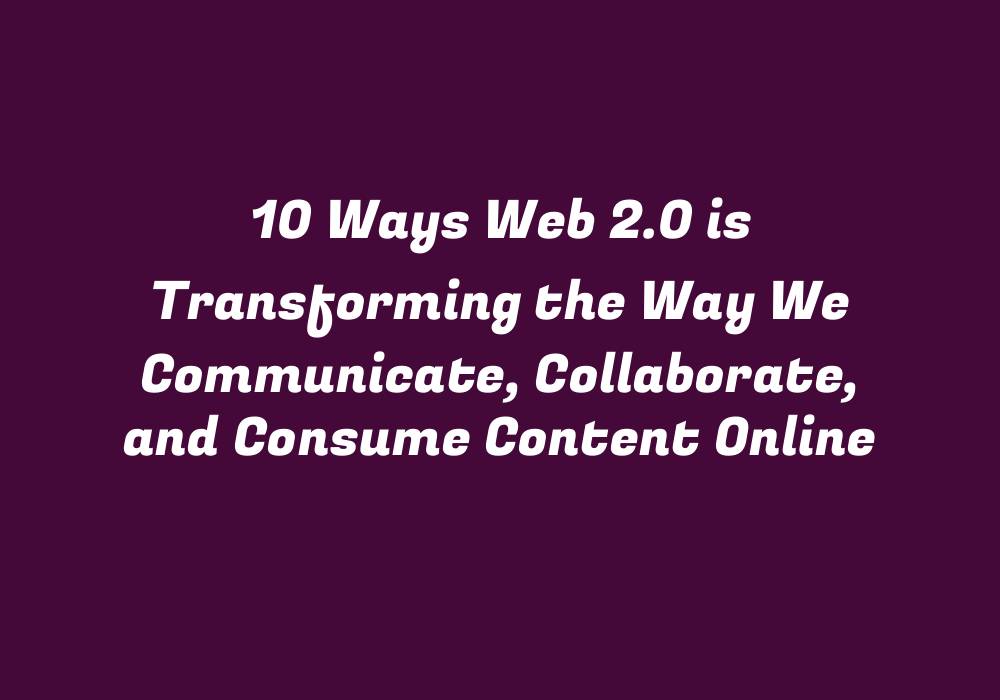Introduction
The internet is constantly evolving, and with each evolution comes new opportunities for individuals to interact and consume content. The advent of Web 2.0 has significantly impacted our online experiences by providing users with enhanced communication methods, seamless collaboration tools, and a more personalized approach to content consumption. In this article, we’ll delve deeper into the various ways that Web 2.0 is revolutionizing how we communicate, collaborate, and access information on the internet.
1. Social Media: The Heart of Digital Communication
Social media platforms like Facebook, Twitter, and Instagram have taken communication to new heights. These networks allow users to share thoughts, connect with friends, and follow their favorite celebrities or businesses. By fostering open dialogues and building a sense of community, social media has become the primary medium for expressing oneself online.
2. Blogging as Personal Expression
Blogs provide individuals with an outlet to share their ideas, stories, opinions, and expertise in various fields. Through blogging platforms like WordPress or Blogger, people can create engaging content, connect with readers, and build a loyal following. This digital medium allows for the expression of unique perspectives that may not find a home elsewhere.
3. Podcasts: Audio Storytelling at its Best
Podcasts have emerged as a powerful tool for storytellers, enabling them to share captivating narratives in an accessible and versatile manner. Users can choose to listen on their preferred device while commuting, exercising or simply relaxing. Podcasts provide an immersive experience that combines auditory content with the intimacy of personal stories.
4. Online Forums: A Hub for Discourse and Debate
Forums are online platforms where users can exchange ideas, share knowledge, and engage in discussions around various topics. Whether it’s a forum dedicated to a specific hobby or a community focused on professional development, these digital meeting places foster intellectual growth by encouraging open dialogue.
5. Online Communities: Connecting People with Shared Interests
Web 2.0 has facilitated the formation of online communities where people with similar interests and goals can connect, share resources, and collaborate. Platforms like Reddit, Quora, and Discord allow users to engage in meaningful conversations, provide assistance to others, and develop a sense of belongingness.
6. Interactive Online Gaming
Online gaming has taken a significant leap forward with the advent of Web 2.0, allowing for increased social interaction and immersive experiences within virtual environments. Games like World of Warcraft or Fortnite offer players the chance to communicate, collaborate, and compete in real-time, creating an entire ecosystem that transcends geographical borders.
7. Collaborative Tools: Working Together in Real Time
Web 2.0 has introduced a plethora of tools that enable teams to work together on projects efficiently and seamlessly from different locations. Platforms like Google Drive, Slack, or Trello have revolutionized the way people collaborate, fostering greater productivity and promoting effective communication within groups.
8. Crowdsourcing: Harnessing Collective Wisdom
Web 2.0 has given rise to crowdsourcing platforms that allow users from around the globe to contribute their expertise, time, and resources towards a common goal. Sites like Kickstarter and Indiegogo have enabled people to fund innovative projects and bring them to fruition by leveraging collective support.
9. Video Streaming: Entertainment in Real Time
Web 2.0 has revolutionized the way we consume video content, with platforms like YouTube and Twitch offering a wide variety of content that can be accessed anywhere at any time. Users have the ability to stream live videos, engage with their favorite creators, or discover new content based on personal preferences.
10. Online Education: Learning Without Boundaries
Web 2.0 has opened doors for individuals seeking education and knowledge by offering a myriad of online learning platforms. Websites like Coursera, Udemy, or edX provide users with access to courses from renowned institutions all over the world. These platforms have significantly reduced geographical barriers, allowing anyone with an internet connection to pursue their educational goals.
Conclusion
The transformation brought about by Web 2.0 has profoundly impacted how we communicate, collaborate, and consume content online. By enabling social interaction, fostering personal expression, and providing innovative tools, the internet has evolved into a powerful medium for sharing knowledge, building communities, and driving cultural change. As we continue to witness technological advancements in Web 3.0, it’s clear that the digital landscape will only become more dynamic and interconnected, ultimately benefiting both individuals and society as a whole.
References
How Web 2.0 is Transforming the Way We Communicate, Collaborate and Consume Content Online
The Impact of Web 2.0 on Communication and Collaboration
The Impact of Web 2.0 on Communication and Collaboration in Business
Web 2.0: Transforming How We Connect, Collaborate, Communicate and Consume
